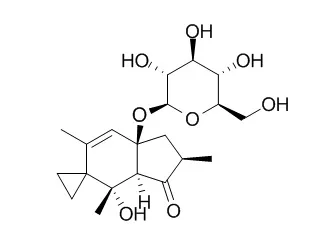| Description: |
Ptaquiloside shows genotoxicity, it also has carcinogenic effects. Ptaquiloside has immunosuppressive effects, it reduces NK cell activities by enhancing metallothionein expression, which is prevented by selenium. |
| Targets: |
Immunology & Inflammation related |
| In vitro: |
| Environ Toxicol Chem. 2005 Nov;24(11):2751-6. | | Genotoxic activity and inhibition of soil respiration by ptaquiloside, a bracken fern carcinogen.[Pubmed: 16398109] | Ptaquiloside (PTA) is a natural toxin produced by bracken (Pteridium aquilinum [L.] Kuhn). Assessment of PTA toxicity is needed because PTA deposited from bracken to soil may leach to surface and groundwater.
METHODS AND RESULTS:
Inhibition of soil respiration and genotoxic activity of PTA was determined by a soil microbial carbon transformation test and an umu test, respectively. In the carbon transformation test, sandy loam soil was incubated at five different initial concentrations of PTA for a period of 28 d, after which glucose was added and respiration measured for 12 consecutive hours. The tests were performed at 20 degrees C and soil moisture content of approximately 15%. For soil material sampled in the autumn, initial PTA concentrations ranging from 0.008 to 40.6 microg PTA/g dry soil were tested. From fitting of data by a sigmoidal function, a 10% effect dose (ED10) was estimated to 13 microg PTA/ g dry soil, with an upper 95% confidence limit of 43 microg PTA/g dry soil and a 95% lower confidence limit of -infinity microg PTA/g dry soil. For soil material sampled in late winter, initial PTA concentrations ranging from 1.56 to 212 microg PTA/g dry soil were tested, resulting in an ED10 value of 55 microg PTA/g dry soil, with an upper 95% confidence limit of 70 microg PTA/g dry soil and a 95% lower confidence limit of 40 microg PTA/g dry soil. The genotoxic activity of PTA was determined using the umu test without and with metabolic activation (addition of S9 rat liver homogenate). In tests with addition of S9, the induction ratio exceeded the critical ratio of 1.5 at a PTA concentration of 46 +/- 16 microg/ml and, in tests without S9, the critical ratio was exceeded at a PTA concentration of 279 +/- 22 microg/ml.
CONCLUSIONS:
The genotoxicity of PTA is comparable to that of quercetin, another bracken constituent. The toxicity of PTA toward microorganisms prolongs the persistence of PTA in terrestrial environments, increasing the risk of PTA leaching to drainage and groundwater. |
|
| In vivo: |
| Toxicology. 2013 Feb 8;304:100-8. | | Ptaquiloside reduces NK cell activities by enhancing metallothionein expression, which is prevented by selenium.[Pubmed: 23274088 ] | Pteridium aquilinum, one of the most important poisonous plants in the world, is known to be carcinogenic to animals and humans. Moreover, our previous studies showed that the immunosuppressive effects of Ptaquiloside, its main toxic agent, were prevented by selenium in mouse natural killer (NK) cells. We also verified that this immunosuppression facilitated development of cancer.
METHODS AND RESULTS:
Here, we performed gene expression microarray analysis in splenic NK cells from mice treated for 14 days with Ptaquiloside (5.3 mg/kg) and/or selenium (1.3 mg/kg) to identify gene transcripts altered by Ptaquiloside that could be linked to the immunosuppression and that would be prevented by selenium. Transcriptome analysis of Ptaquiloside samples revealed that 872 transcripts were expressed differentially (fold change>2 and p<0.05), including 77 up-regulated and 795 down-regulated transcripts. Gene ontology analysis mapped these up-regulated transcripts to three main biological processes (cellular ion homeostasis, negative regulation of apoptosis and regulation of transcription). Considering the immunosuppressive effect of Ptaquiloside, we hypothesized that two genes involved in cellular ion homeostasis, metallothionein 1 (Mt1) and metallothionein 2 (Mt2), could be implicated because Mt1 and Mt2 are responsible for zinc homeostasis, and a reduction of free intracellular zinc impairs NK functions. We confirm these hypotheses and show increased expression of metallothionein in splenic NK cells and reduction in free intracellular zinc following treatment with Ptaquiloside that were completely prevented by selenium co-treatment.
CONCLUSIONS:
These findings could help avoid the higher susceptibility to cancer that is induced by P. aquilinum-mediated immunosuppressive effects. |
|






 Cell. 2018 Jan 11;172(1-2):249-261.e12. doi: 10.1016/j.cell.2017.12.019.IF=36.216(2019)
Cell. 2018 Jan 11;172(1-2):249-261.e12. doi: 10.1016/j.cell.2017.12.019.IF=36.216(2019) Cell Metab. 2020 Mar 3;31(3):534-548.e5. doi: 10.1016/j.cmet.2020.01.002.IF=22.415(2019)
Cell Metab. 2020 Mar 3;31(3):534-548.e5. doi: 10.1016/j.cmet.2020.01.002.IF=22.415(2019) Mol Cell. 2017 Nov 16;68(4):673-685.e6. doi: 10.1016/j.molcel.2017.10.022.IF=14.548(2019)
Mol Cell. 2017 Nov 16;68(4):673-685.e6. doi: 10.1016/j.molcel.2017.10.022.IF=14.548(2019)